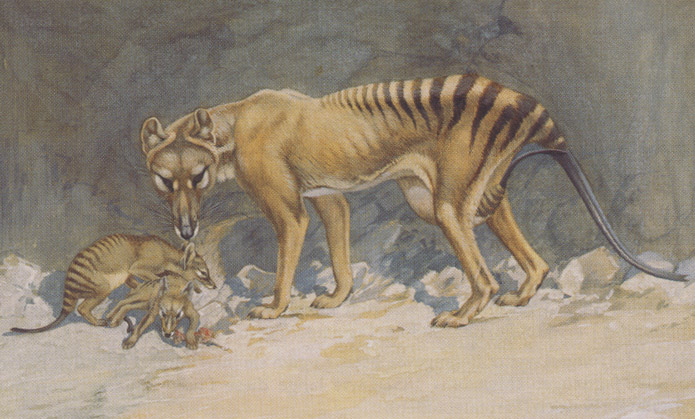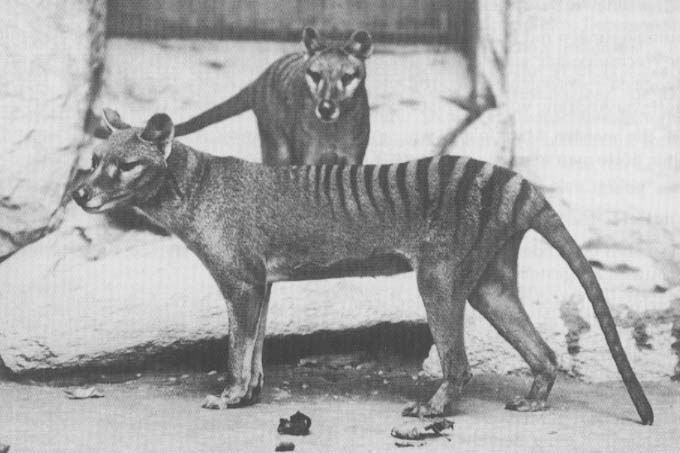Family History of the Smithsonian Thylacine
At the close of the nineteenth century, no American zoo had found itself able
to display the largest marsupial predator of modern times, the thylacine
(Thylacinus cynocephalus), and concern about the animal's increasing
rarity in its native Tasmania was mounting.
At the urging of the National Zoo in Washington D.C., an American official
stationed in Australia finally arranged for a wild-captured thylacine to be
shipped to the United States in early 1902. This female thylacine was pregnant
when captured, and soon after, in April, gave birth to three tiny, naked pouch
young. After months of crated transport, first by boat across the Pacific and
then by train across the American continent, the thylacine mother arrived at
the zoo on September 3 with her three offspring, by now furred and the size
of rabbits (Fig. 1). Ill from the long journey, one of the cubs died nine
days later. The mother lived for two years at the zoo, and her two
remaining offspring, male and female, survived into adulthood.
More details about the thylacine family's history can be found in a
paper by Chris Wemmer.

|
|
Figure 1. A 1902
painting by Joseph Gleeson depicts a thylacine mother
with three cubs (including one in the pouch) as they appeared on arrival at the
National Zoo (photo courtesy of Smithsonian Archives). Our study sampled hairs
from the mother and one of the cubs.
|
This particular thylacine family has loomed large in the study of the species,
both in life and death. The longer surviving offspring, subjects of one of the
most famous photographs of the species (Fig. 2), provided a very rare example of
thylacine young surviving to maturity in a zoo. When the zoo obtained another,
adult male thylacine from Tasmania in 1904, the surviving daughter was the subject
of one of few attempts at captive breeding, ultimately unsuccessful.
All of these thylacines are today preserved as specimens in the United States
National Museum of Natural History (USNM), Smithsonian Institution, where they
have been studied by several generations of comparative morphologists. The mother,
on display at USNM as a taxidermy mount since 1904, can still be viewed in the
museum's public galleries, where it has been seen by tens of millions of visitors.
Notably, the accompanying skeleton of this specimen has been the subject of
previous efforts to obtain thylacine molecular sequence data using ancient-DNA
protocols, and the USNM thylacines provide a partial focus for our study as well.

|
|
Figure 2. Among
the highest quality of known thylacine photographs,
this portrait apparently depicts the two surviving offspring (see Fig. 1)
two to three years after their arrival at the National Zoo.
One of these animals (most likely the one in front) is USNM 125345, a specimen
sequenced for this study (photo courtesy of Smithsonian Archives).
High-resolution version (778,355 bytes).
|
The first Smithsonian specimen we investigated was the mother, USNM 124662 (skin) /
49723 (skull), adult female, which died at the National Zoo in 1904. We sampled
< 0.1 gram of hair from the left side and the hair tufts between several toes,
without appreciable damage to the skin. The right side of the skin was left fully
intact. This had been used in an earlier unsuccessful study by other authors,
and we were unable to recover thylacine DNA from it.
Our second attempt used the
specimen that was the offspring (son) of the first
specimen. The same mitochondrial sequence is of course to be expected, since
mitochondrial genome sequences are inherited solely from the mother. This
specimen was USNM 125345 (skin) / 49724 (skull), adult male, which died at the
National Zoo in 1905. The skin of this specimen is prepared as a scientific
study skin; it is housed in the USNM scientific collections and has not been
on display since its death. We sampled approximately 0.01 gram of hair from
the right side of the skin and from the hair tufts between the toes on the
right hindfoot, without appreciable damage to the skin. The left side of the
skin was left fully intact.

